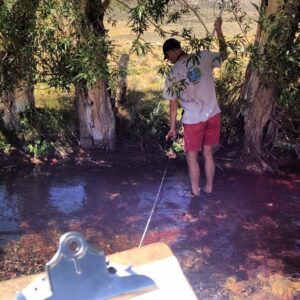

This post was written by Ben Hand, 2012 Mono Lake Intern.
For many Mono Lake interns, one of the main draws of working for the Mono Lake Committee is the opportunity to work outdoors in the Mono Basin. One of the opportunities to do this is the weekly stream monitoring that the Committee carries out at Mill Creek. Mill Creek monitoring, as we call it around the office, is part of the broad effort to track the status of the streamflows and ecology of the five creeks that feed Mono Lake from the Sierra Nevada.
Each week, two interns drive to Lundy Lake and spend the next two to three hours monitoring the flows of Mill Creek and the Wilson diversion system at various points between Lundy and Mono Lake itself. This involves various measurement techniques at different points. At some locations measuring the water level takes no more effort or technique than walking down to the water’s edge and reading the height off of a measurement rubric taped to the side of a water flume. But in places where there is not a flume, more complicated methods are required.

The method we generally use involves breaking a section of the stream into quadrants, and measuring the amount of water flowing, in cubic feet per second, at each one of the quadrants. This gives us a rough idea of how much water is passing through Mill Creek at various points along its course, and whether water is being lost along the way. It also helps us keep track of whether the creek is carrying a sufficient amount of water to sustain the habitat that depends on it to survive. We also note other features of Mill Creek, such as whether water is being used to irrigate a particular meadow or flowing with sufficient force to drag small boulders along with the current (not a concern this dry season, as you might imagine). All of these observations help us get a more precise picture of the health of Mill Creek and the habitat that depends on it, as well as the larger state of water use in the Mono Basin.
Monitoring streamflow in the Mono Basin is one of those wonderful tasks that befall the Mono Lake interns that both contributes handily to the mission of our organization, and also allows interns to spend time out in the natural environment that they have grown to love. Spending time outside in the Mono Basin each week adds to a long-term set of quantitative data on the state of the streams, and it also gives us a chance to simply observe them in action, which in turns helps us be better interpreters of the basin for visitors. We look forward to our chance to monitor every week!
